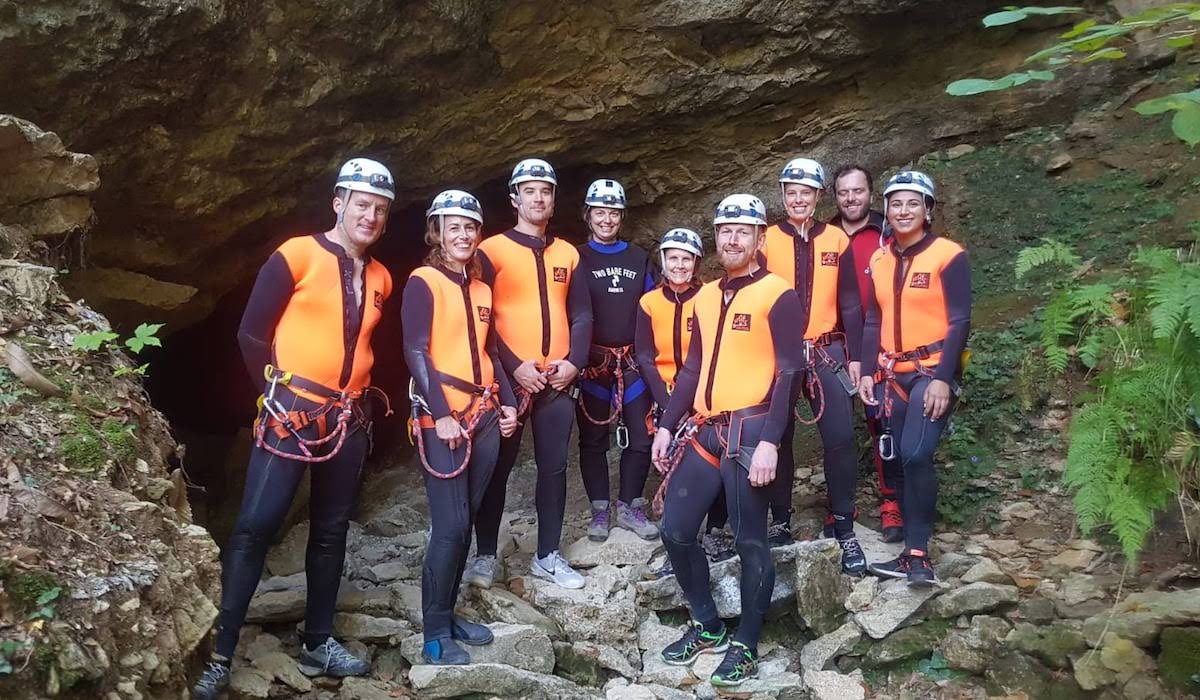By Elizabeth Heath
“I need an XL,” I told the guide as he handed out wetsuits.
He looked me up and down and handed me an L. Flattering, but I knew it wasn’t going to fit. But I struggled nonetheless, half-naked, to stretch the size L sausage casing over my calves. It wasn’t happening. As I put my clothes on to go back out into the October chill and get an XL, I muttered to myself, “F***ing Italians.” That’s when I realized I was sharing the dressing room with an Italian woman.
“Don’t worry,” she laughed. “I know what you mean.”
The XL was also too small to fit over my calves. The guides finally dug out a suit made of thinner, stretchier material that slid easily over my aforementioned calves and ample hips.
I may have looked like a grey, neoprene-clad version of the Michelin Man, but at least I could breathe. And I’d made a new friend, Cora, the understanding Italian woman. I figured I’d need a pal, since I was about to don a helmet and headlamp and crawl on my hands and knees through a frigidly cold river and into a million-year-old cavern.
We formed part of a group of nine travel industry professionals who were about to be introduced to the adventurous, wild side of Tuscany—the corners of the region that are all about kayaking, canyoneering, mountain biking and hiking.
The experience was offered by That’s Tuscany, an agency dedicated to responsible, low-impact travel. It’s part of the region’s wider effort to achieve a more sustainable kind of tourism by encouraging visitors to look beyond Tuscany’s crowded—albeit gorgeous—cities and into its lesser-known corners.
Standing at the mouth of that cave, I had a feeling we weren’t in Florence anymore.
Instead, we were in the woods just outside Fornovolasco, a town of just a few dozen residents deep in the Garfagnana, a mountainous geographical region near Lucca in far northwest Tuscany.
We were within the Apuan Alps Geopark, about to enter the Tana che Urla, which translates to “the Howling Cave” and sounds sufficiently ominous in any language. Under the shade of chestnut trees on a cool, sunny morning, the Howling Cave didn’t seem so scary, but I was nervous all the same.
“If I get in there and find out this isn’t for me, can I come back out?” I asked Danilo, the lead of our three guides and principal with Apians, which organizes adventures in the Garfagnana (part of the province of Lucca, in Tuscany).
“Of course,” he said. “But you’ll be fine.”
It wasn’t claustrophobia or fear of bats that had me concerned; it was the brutta figura—the Italian term for making a bad impression.
At 52, I was probably the oldest member of the group and easily the least fit. My moderate level of fitness could get me through a high-intensity workout at the gym, but I wasn’t sure it would be enough to get me in and out of that cave without having to ask for help—and embarrassing myself worried me a lot more than some silly bat flitting around my head.
I was a first-time spelunker among uber-fit adventurers, some of whom climb glaciers and bungee-jump for a living. In my mismatched, saggy wetsuit and not at all confident that I could complete the challenge ahead of me, I felt very much a fish out of water. Or a bat out of its cave.

To enter the Howling Cave, we first crawled on our hands and knees for several meters, through the cold water of a rocky riverbed. From there, we entered a large chamber, illuminated by our headlamps. After a quick lesson on how to use carabiners to attach our harnesses to ropes anchored along the chamber wall, I was soon belaying—clumsily, but I was belaying!—horizontally over a deeper stretch of the same river.
Soon, we were hopping rock to rock, straddling a crevasse of rushing water, with jagged rocks breaking the surface. We moved quickly—too quickly for me to be scared thinking about the nasty injury I’d sustain if fell into the rocky abyss below.
I didn’t slip, or struggle to find a foothold—I just did it, Yoda-style (“There is no try”). I was starting to think I might survive this crazy adventure, even if Øyvind, a strapping Norwegian guy who takes people ice-climbing above the Arctic Circle, kept asking me if I was doing okay—that had me worried again about that dreaded brutta figura.
At the end of the crevasse, we assembled at the base of the roaring waterfall from which the Howling Cave gets its name. I was first in line and waited as a guide scrambled up the falls, anchored a rope and threw it down to me. I attached it to my carabiner and waited, expecting to be pulled up the falls. Now that was some magical thinking.
“Go ahead,” said Danilo, gesturing to the rocks protruding from the face of the waterfall. “Climb.”
I climbed. And climbed, and climbed. With water rushing around and all over me, I found my foot- and hand-holds and to my infinite surprise, about 15 meters later, I was at the top of the waterfall. Cora arrived soon after, then Pari, then a few more of my cave companions. Cora grabbed my hand and we both smiled and sighed, exhilarated. “Can you believe we’re doing this?” I asked, to no one and everyone.
We sat on a massive, slanting slab of stone as we waited for the others to arrive, and drank from the sheet of water that ran along the smooth rock face. It was only then that I had a moment to consider where I was and what I was doing—what I had already done.
I knew that later my knees would be howling as loudly as the Howling Cave, but at that moment, my sense of satisfaction and accomplishment was so immense that I wasn’t thinking about my knees—or of making a fool of myself among my fitter peers.
Our Tuscany adventure wasn’t finished, either. Over the next few hours, we would wade into a freezing underground lake, scramble over rock shelves, and then descend into a silent chamber, turn off our headlamps and learn the true meaning of pitch blackness.
One optional section required us to shimmy on our backs through a narrow opening, the cave ceiling just inches from our noses. “Will my ass fit through there?” I asked Andrea, another of our guides. Maybe it would be better for me to take the detour? “Move it,” he said, pointing to the skinny route. I went for it. I shimmied. I fit.
When it was time to turn back, we reversed course and did the whole route again, backwards. Except for this time I rappelled down that waterfall like a boss. By the time we crawled out of the cave, I had proven to myself that I could do something which, for me, seemed nearly physically impossible.
The next day at the travel conference we all attended, I ran into Øyvind the Ice Climber, who spontaneously and warmly hugged me—I think he was genuinely relieved that I was alive.
Maybe next time I decide to undertake a physical and mental challenge akin to the Howling Cave in Tuscany, I’ll try ice-climbing in Norway. But for the time being, I’ll settle for the feeling of accomplishment I got out of that half-day in a cave in Tuscany.
I did climb a waterfall, after all.
. . .

Elizabeth Heath is a travel and culinary writer living in central Italy. She is a proponent of responsible, sustainable travel that forges connections and benefits local communities. Read more of her work at elizabethfheath.com.

